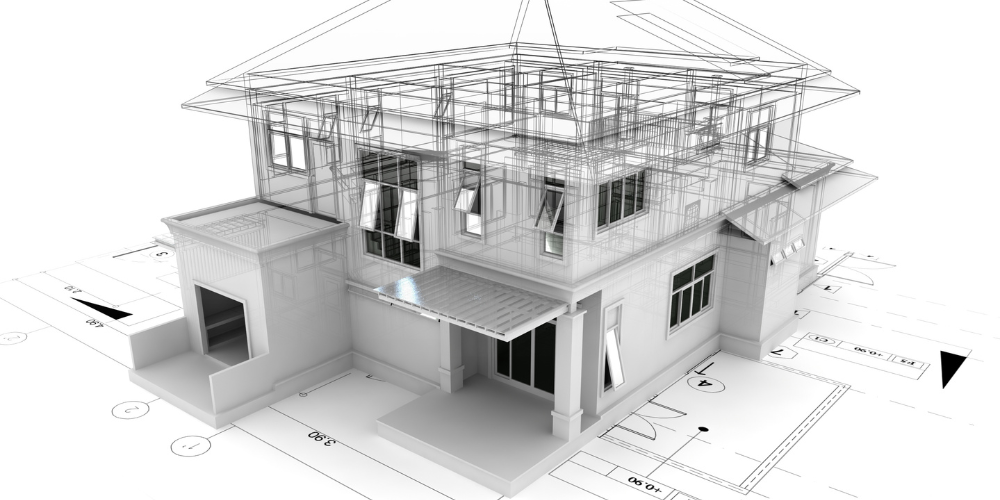6 min read
Advancements in Construction Technology
By: Camille Henderson w/ Spencer Powell on Mar. 20, 2025

The construction industry isn’t exactly known for being cutting-edge—at least, not in the same way as, say, Silicon Valley. For decades, progress in construction technology felt like it moved at the speed of a cement truck going uphill. But in recent years, innovation has kicked into high gear, bringing game-changing advancements that transform how homes and buildings are designed, built, and managed.
Builder Funnel is uniquely positioned to monitor these shifts because we work with only builders and remodelers and have a bird's-eye view of rising trends. So, what’s next? What tech is here to stay, and what still feels like something out of a sci-fi movie? Let’s break down the biggest advancements shaping the future of construction and what they mean for builders, remodelers, and the industry as a whole.

The Rise of Smart Construction: Data-Driven, Automated, and Efficient
Technology has taken the guesswork out of construction. Builders have new, powerful tools that make planning, designing, and executing projects more precise than ever.
Building Information Modeling (BIM): The Digital Twin Revolution
Gone are the days of sifting through stacks of blueprints and hoping for the best. Building Information Modeling (BIM) allows architects, builders, and project managers to create intelligent 3D models that provide real-time insights into a project’s design, materials, costs, and potential problem areas. It’s like having X-ray vision for your build, but no one has to (gets to?) wear a spandex superhero suit.
- Reduces errors and rework by catching design conflicts before construction begins.
- Improves collaboration by giving teams a shared, up-to-date model.
- Enhances efficiency by integrating scheduling, budgeting, and material tracking.
Artificial Intelligence (AI) and Machine Learning: Smarter Decisions, Fewer Mistakes
In construction, AI and machine learning are revolutionizing everything from project planning to risk assessment. These technologies analyze vast amounts of data to predict project delays, identify safety hazards, and optimize workflows.
- AI-powered scheduling tools help keep projects on track by identifying bottlenecks before they cause delays.
- Machine learning algorithms can analyze past projects to improve budgeting accuracy.
- AI-driven safety monitoring reduces on-site accidents by spotting risks in real time.

Virtual Reality (VR) & Augmented Reality (AR): See It Before You Build It
What if homeowners could walk through their new house before it’s built? New tools allow architects, designers, and clients to visualize spaces in full 3D, making it easier to spot design issues and make changes before construction starts.
- VR simulations allow clients to explore a digital model of their home, making design approvals easier.
- AR overlays help builders see structural plans in real time while on-site.
- Reduces costly changes mid-project by catching issues before they become problems.
The Internet of Things (IoT) in Construction: Smarter Job Sites
If your thermostat can talk to your phone, why shouldn’t construction sites have the same level of connectivity? IoT technology uses smart sensors and connected devices to track everything from equipment usage to structural stability.
- Smart sensors monitor job site conditions, helping prevent safety hazards.
- Connected equipment reports maintenance needs before breakdowns occur.
- Real-time tracking of materials and tools reduces delays and loss.
Advanced Data Analytics & Predictive Maintenance: Avoiding Problems Before They Happen
Think of predictive maintenance as the difference between fixing a leaky pipe before it floods the basement versus waiting until your house turns into an indoor swimming pool. By using sensors, historical data, and AI, construction teams can anticipate equipment failures, structural weaknesses, and material inefficiencies before they lead to costly repairs.
- Sensors track equipment performance to predict when maintenance is needed.
- Data analytics help optimize material usage, reducing waste and saving money.
- Predictive models improve long-term durability by identifying weak points early.

Construction Goes High-Tech: Robotics, Drones, and Automation
The days of relying solely on manpower to get the job done are fading fast. With labor shortages continuing to challenge the industry, technology is stepping in to pick up the slack, sometimes literally. From drones capturing real-time site data to robots laying bricks with machine-like precision, construction sites are becoming more automated, efficient, and, let’s be honest, a little futuristic.
Drones for Site Surveys & Inspections: Eyes in the Sky
Why send someone up a shaky ladder when you can send a drone instead? Drones have become a game-changer in construction, offering a faster, safer, and more cost-effective way to survey job sites, inspect progress, and gather data.
- Can map out large sites in minutes instead of days.
- Improve safety by reducing the need for risky manual inspections.
- Provide high-resolution imagery for tracking progress and spotting potential issues early.
Robotics in Construction: The Future is Automated
Robots are now on job sites, laying bricks, tying rebar, and even 3D-printing entire structures. Construction robotics help fill labor gaps, reduce human error, and keep projects moving faster than ever.
- Bricklaying robots like SAM (Semi-Automated Mason) can lay thousands of bricks daily, way more than even your fastest mason.
- Rebar-tying robots automate one of the most repetitive and physically demanding tasks.
- 3D printing robots create walls, facades, and even entire buildings with precision and speed.
Exoskeletons for Labor Efficiency: Strength Meets Safety
Construction work is tough on the body, but exoskeletons are helping workers perform physically demanding tasks with less strain. Think of it as a more mundane Iron Man suit, minus the billionaire backstory.
- Reduces fatigue and injury risk by supporting heavy lifting and repetitive motions.
- Increases worker efficiency and endurance on long job days.
- Improves overall job site safety and longevity for skilled laborers.
Autonomous & Electric Construction Equipment: The Next Frontier
While fully autonomous construction vehicles aren’t quite taking over just yet, we’re getting closer. Self-driving bulldozers, excavators, and loaders are in development, using GPS and AI to handle site prep and earthmoving with minimal human intervention. Plus, with electric construction equipment making strides, the industry is slowly moving toward quieter, cleaner, and more sustainable machinery.
- Autonomous earthmovers can dig, grade, and clear sites with minimal supervision.
- Electric-powered machinery reduces emissions and noise pollution.
- AI-powered controls improve precision and reduce fuel costs.

Smarter Materials and Sustainable Building Practices
With rising material costs, stricter environmental regulations, and growing demand for energy-efficient homes, the construction industry is rethinking how buildings are made. Enter smart materials, self-healing concrete, and green construction technologies that aim to reduce waste, cut energy consumption, and make structures more durable than ever. But the big question remains: Has green building finally become affordable, or is it still a premium investment? Let’s break it down.
Smart Materials & Self-Healing Concrete: Built to Last
Imagine a material that fixes itself when it cracks. Self-healing concrete does exactly that, using embedded bacteria or chemical agents that activate when exposed to moisture. It’s like having a house that can heal its own minor wounds, just like its occupants.
- Extends the lifespan of structures by automatically repairing small cracks.
- Reduces maintenance costs and long-term deterioration.
- Improves sustainability by minimizing material waste and repairs.
Meanwhile, smart materials, like glass that adjusts its tint based on sunlight or insulation that adapts to temperature changes, are helping buildings become more energy-efficient without extra effort from homeowners.
Green Construction & Sustainability: The Cost vs. Benefit Debate
For years, one of the biggest roadblocks to sustainable building has been cost. Energy-efficient windows, solar panels, and high-performance insulation all save money in the long run, but they often come with higher upfront expenses. So, has anything changed? While green building isn’t “cheap” yet, the cost gap is shrinking, and with long-term savings in energy bills, it’s becoming harder to justify NOT going green.
- Material costs for green tech have started to drop as demand increases.
- Energy codes and incentives are making sustainable choices more financially viable.
- Consumer demand is driving builders to offer energy-efficient options as a standard.
Energy-Efficient Building Technologies: Smarter Homes, Lower Bills
Builders are increasingly incorporating energy-efficient materials and smart systems to meet consumer expectations and future-proof homes. Some of the biggest game-changers include.
- Solar-integrated roofing that looks like shingles instead of an afterthought.
- High-performance insulation keeps homes comfortable with minimal energy loss.
- Energy-monitoring smart home tech adjust heating, cooling, and lighting automatically to reduce waste.

The Future of Construction: What’s Next?
We’ve already seen massive leaps in construction technology, but the best (and maybe the weirdest) innovations are still on the horizon. From 3D-printed houses to blockchain-secured contracts, the future of construction is shaping up to be faster, smarter, and more efficient than ever. So, what’s coming next? Let’s take a look at the trends that are poised to shake up the industry.
3D Printing & Modular Construction: Faster, Cheaper, and Less Waste
The idea of “printing” a house sounds like something out of The Jetsons, but 3D printing is already changing the game in home construction. By layering concrete or composite materials, 3D printers can create walls and entire structures in a fraction of the time it takes using traditional methods.
- Cuts construction time dramatically – Some 3D-printed homes are built in just 24 hours.
- Reduces material waste by using only what’s needed.
- More affordable housing solutions could help combat the housing crisis.
Prefabrication & Off-Site Construction: The Rise of Factory-Built Homes
Gone are the days when “prefab” meant flimsy, cookie-cutter designs. Today’s off-site construction techniques produce high-quality, customizable homes and buildings with incredible efficiency.
- Controlled environments reduce delays caused by weather or labor shortages.
- Faster build times mean homes can be completed in weeks instead of months.
- Higher quality control leads to fewer mistakes and a more precise build.
Blockchain for Contracts & Payments: Bringing Transparency to Construction
Blockchain isn’t just for cryptocurrency bros. It has real-world applications in construction. By securing contracts, tracking payments, and improving transparency, blockchain technology could reduce fraud, speed up transactions, and eliminate costly disputes.
- Smart contracts automatically release payments when milestones are met.
- Immutable records ensure that contract details can’t be altered or lost.
- Reduces paperwork and speeds up project funding.

Stay Ahead of the Curve With Builder Funnel
The construction industry is evolving fast, and staying ahead means embracing the latest technology and trends. But keeping up with the changes while also running a business is no small task. That’s where we come in.
Builder Funnel specializes in helping construction companies, home builders, and remodelers grow through strategic marketing that connects you with the right clients, builds your authority, and keeps your brand ahead of the competition. Ready to take your construction business to the next level? Let’s talk about how we can help.

